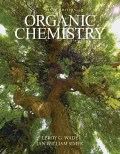
EBK ORGANIC CHEMISTRY
9th Edition
ISBN: 8220102744097
Author: SIMEK
Publisher: PEARSON
expand_more
expand_more
format_list_bulleted
Concept explainers
Question
Chapter 9, Problem 9.38SP
Interpretation Introduction
Interpretation: The structure of compound
Concept introduction: The notations
To determine: The structure for compound
Expert Solution & Answer
Trending nowThis is a popular solution!

Students have asked these similar questions
23.34 Show how to convert each starting material into isobutylamine in good yield.
ཅ ནད ཀྱི
(b)
Br
OEt
(c)
(d)
(e)
(f)
H
Please help me Please use https://app.molview.com/ to draw this. I tried, but I couldn't figure out how to do it.
Propose a synthesis of 1-butanamine from the following:
(a) a chloroalkane of three carbons
(b) a chloroalkane of four carbons
Chapter 9 Solutions
EBK ORGANIC CHEMISTRY
Ch. 9.1 - a. Count the elements of unsaturation in...Ch. 9.2 - Prob. 9.2PCh. 9.4B - What reaction would acetylene likely undergo if it...Ch. 9.6 - Prob. 9.4PCh. 9.6 - Predict the products of the following acid-base...Ch. 9.7A - Solved Problem9-1 showed the synthesis of...Ch. 9.7A - Show how you might synthesize the following...Ch. 9.7B - Prob. 9.8PCh. 9.7B - Show how you would synthesize...Ch. 9.8 - When 2,2-dibromo-1-phenylpropane is heated...
Ch. 9.8 - When 2,2-dibromo-1-phenylpropane is heated...Ch. 9.9C - Show how you would convert a. oct-3-yne to...Ch. 9.9C - The fragrance of (Z)-1-phenylhex-2-en-1-ol...Ch. 9.9D - In the addition of just 1 mole of bromine to 1...Ch. 9.9E - Propose a mechanism for the entire reaction of...Ch. 9.9E - Predict the major product(s) of the following...Ch. 9.9E - Propose a mechanism for the reaction of pent-1-yne...Ch. 9.9E - Show how hex-1-yne might be converted to a....Ch. 9.9F - When pent-2-yne reacts with mercuric sulfate in...Ch. 9.9F - Prob. 9.20PCh. 9.9F - Prob. 9.21PCh. 9.9F - Prob. 9.22PCh. 9.10A - Predict the product(s) you would expect from...Ch. 9.10B - Prob. 9.24PCh. 9.10B - Prob. 9.25PCh. 9 - Prob. 9.26SPCh. 9 - Give common names for the following compounds. a....Ch. 9 - Prob. 9.28SPCh. 9 - Prob. 9.29SPCh. 9 - Using cyclooctyne as your starting material, show...Ch. 9 - Prob. 9.31SPCh. 9 - Prob. 9.32SPCh. 9 - Predict the products of reaction of pent-1-yne...Ch. 9 - Show how you would accomplish the following...Ch. 9 - Show how you would synthesize the following...Ch. 9 - Predict the products formed when CH3CH2C C : Na+...Ch. 9 - Prob. 9.37SPCh. 9 - Prob. 9.38SPCh. 9 - When compound Z is treated with ozone, followed by...Ch. 9 - Show how you would convert the following starting...Ch. 9 - The following functional-group interchange is a...Ch. 9 - Using any necessary inorganic reagents, show how...Ch. 9 - Prob. 9.43SP
Knowledge Booster
Learn more about
Need a deep-dive on the concept behind this application? Look no further. Learn more about this topic, chemistry and related others by exploring similar questions and additional content below.Similar questions
- Select the stronger base from each pair of compounds. (a) H₂CNH₂ or EtzN (b) CI or NH2 NH2 (c) .Q or EtzN (d) or (e) N or (f) H or Harrow_forward4. Provide a clear arrow-pushing mechanism for each of the following reactions. Do not skip proton transfers, do not combine steps, and make sure your arrows are clear enough to be interpreted without ambiguity. a. 2. 1. LDA 3. H3O+ HOarrow_forwardb. H3C CH3 H3O+ ✓ H OHarrow_forward
- 2. Provide reagents/conditions to accomplish the following syntheses. More than one step is required in some cases. a. CH3arrow_forwardIdentify and provide an explanation that distinguishes a qualitative and quantitative chemical analysis. Provide examples.arrow_forwardIdentify and provide an explanation of the operational principles behind a Atomic Absorption Spectrometer (AAS). List the steps involved.arrow_forward
- Instructions: Complete the questions in the space provided. Show all your work 1. You are trying to determine the rate law expression for a reaction that you are completing at 25°C. You measure the initial reaction rate and the starting concentrations of the reactions for 4 trials. BrO³¯ (aq) + 5Br¯ (aq) + 6H* (aq) → 3Br₂ (l) + 3H2O (l) Initial rate Trial [BrO3] [H*] [Br] (mol/L) (mol/L) | (mol/L) (mol/L.s) 1 0.10 0.10 0.10 8.0 2 0.20 0.10 0.10 16 3 0.10 0.20 0.10 16 4 0.10 0.10 0.20 32 a. Based on the above data what is the rate law expression? b. Solve for the value of k (make sure to include proper units) 2. The proposed reaction mechanism is as follows: i. ii. BrО¸¯ (aq) + H+ (aq) → HBrO3 (aq) HBrO³ (aq) + H* (aq) → H₂BrO3* (aq) iii. H₂BrO³* (aq) + Br¯ (aq) → Br₂O₂ (aq) + H2O (l) [Fast] [Medium] [Slow] iv. Br₂O₂ (aq) + 4H*(aq) + 4Br(aq) → 3Br₂ (l) + H2O (l) [Fast] Evaluate the validity of this proposed reaction. Justify your answer.arrow_forwardе. Д CH3 D*, D20arrow_forwardC. NaOMe, Br Brarrow_forward
arrow_back_ios
SEE MORE QUESTIONS
arrow_forward_ios
Recommended textbooks for you

 Organic ChemistryChemistryISBN:9781305580350Author:William H. Brown, Brent L. Iverson, Eric Anslyn, Christopher S. FootePublisher:Cengage Learning
Organic ChemistryChemistryISBN:9781305580350Author:William H. Brown, Brent L. Iverson, Eric Anslyn, Christopher S. FootePublisher:Cengage Learning Organic And Biological ChemistryChemistryISBN:9781305081079Author:STOKER, H. Stephen (howard Stephen)Publisher:Cengage Learning,
Organic And Biological ChemistryChemistryISBN:9781305081079Author:STOKER, H. Stephen (howard Stephen)Publisher:Cengage Learning, General, Organic, and Biological ChemistryChemistryISBN:9781285853918Author:H. Stephen StokerPublisher:Cengage Learning
General, Organic, and Biological ChemistryChemistryISBN:9781285853918Author:H. Stephen StokerPublisher:Cengage Learning


Organic Chemistry
Chemistry
ISBN:9781305580350
Author:William H. Brown, Brent L. Iverson, Eric Anslyn, Christopher S. Foote
Publisher:Cengage Learning

Organic And Biological Chemistry
Chemistry
ISBN:9781305081079
Author:STOKER, H. Stephen (howard Stephen)
Publisher:Cengage Learning,

General, Organic, and Biological Chemistry
Chemistry
ISBN:9781285853918
Author:H. Stephen Stoker
Publisher:Cengage Learning
General Chemistry | Acids & Bases; Author: Ninja Nerd;https://www.youtube.com/watch?v=AOr_5tbgfQ0;License: Standard YouTube License, CC-BY